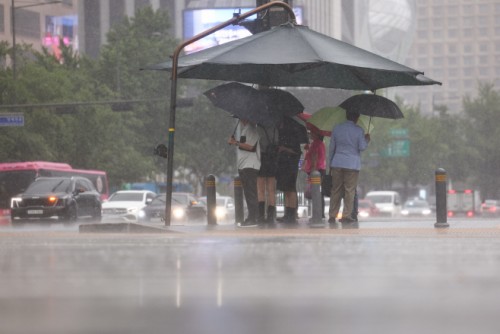 |
| Pedestrians wait at a crosswalk under umbrellas at Gwanghwamun intersection in central Seoul on June 20, as a heavy rain advisory was issued across the capital. / Source: Yonhap News |
The Ministry of the Interior and Safety activated Level 1 of the Central Disaster and Safety Countermeasures Headquarters (CDSCH) on June 20 as heavy rain warnings were issued for the Seoul metropolitan area and Gangwon Province. The decision was made at 2:30 p.m. as torrential rainfall began affecting large parts of the country.
According to the Korea Meteorological Administration (KMA), a stationary front is currently bringing downpours of around 30 millimeters per hour to the capital region and Gangwon. The front is expected to shift southward overnight into June 21, potentially unleashing heavy rain across the Chungcheong and Jeolla regions.
Forecasts estimate that total precipitation between June 20 and 21 will range from 30 to 80 millimeters in the Seoul metropolitan area, with some locations expected to receive more than 120 millimeters. In Gangwon Province’s inland and mountainous regions, rainfall is projected to reach between 50 and 100 millimeters, also with localized areas possibly exceeding 120 millimeters. The Chungcheong region is expected to see between 50 and 100 millimeters of rain, with maximum amounts reaching up to 180 millimeters. Similarly, North Jeolla Province is forecast to receive 50 to 100 millimeters, with heavier rainfall of up to 180 millimeters possible in certain areas.
In response, the CDSCH urged relevant agencies to remain on high alert and take thorough preemptive measures to minimize damage. Authorities stressed the importance of using all available communication tools — including emergency text alerts and village broadcasts — to inform the public about weather conditions, urge people to avoid outdoor activities during peak rainfall, and restrict access to vulnerable areas.
Special attention was directed toward areas previously affected by floods and wildfires, landslide-prone zones, riversides, and underground spaces. Officials called for enhanced surveillance of these high-risk areas, and emphasized the need for swift restriction of access and evacuation of residents should risks arise.
The CDSCH also called on local governments and first responders to ensure the safety of vulnerable populations, including the elderly and mobility-impaired, through regular check-ins and support during potential evacuations.
In addition, the Ministry emphasized real-time information sharing between municipalities, police, fire services, and other related agencies. Authorities were instructed to strengthen coordinated response efforts upon detecting any signs of danger.
A CDSCH official stated, “We will manage the situation closely and do everything we can to minimize damage caused by this heavy rainfall.”
Most Read
-
1
-
2
-
3
-
4
-
5
-
6
-
7





















